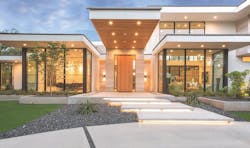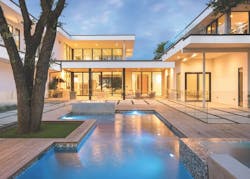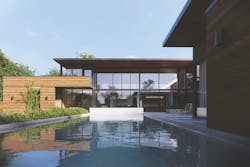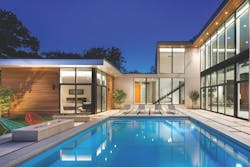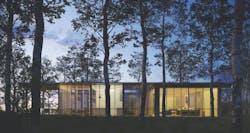Bauhaus School of Design | All Over Modern
About a hundred years ago, the Bauhaus school of art and design was founded in Weimar, Germany, with the goal of uniting all branches of the arts under one roof. The Bauhaus made its mark by focusing on combining craft, art, and architecture, and its enduring influence has shaped the design of everything from buildings to furniture to typefaces. This approach influenced the founding of Bauhaus Modern Homes, a Dallas design/build firm that works in architectural styles from classic European to mid- century modern.
“Bauhaus design philosophy also intends to include technology,” which is one of the driving forces behind BMH, says designer Marc Kleinmann, the firm’s founder. Since BMH’s inception in 2007, Kleinmann has been applying Bauhaus principles to his designs and business operations.
Photo: Costa Christ
Modern Style
Born and raised near Stuttgart, Germany, Kleinmann embraced Bauhaus design with visits to nearby Weissenhof, a 1927 housing estate that includes homes designed by modernist icons Le Corbusier, Ludwig Mies van der Rohe, and Walter Gropius.
Kleinmann, who learned the business side of construction from his father, a real estate developer and builder, is a self-taught architectural designer. He got a degree in real estate development and construction management from the European Real Estate Academy in SaarbrÜcken, Germany, and then went to work for his father. “But we didn’t see eye to eye on procedures and operations,” Kleinmann says. “My father was more of a one-man show when it came to business.”
In 1996, Kleinmann struck out on his own for Dallas to flex his design muscle, working in the film and visual effects industry. He and his then-wife began flipping houses as a side gig. “9/11 put the nail in the coffin for the visual effects world,” he says, so they made house flipping a permanent business. He started BMH as a custom home build-only firm.
The three elements crucial to mid-century modern architecture—clean lines, connection with the site, and transparency—combine in this design to create a timeless aesthetic (Photo: Courtesy Bauhaus Modern Homes).
Today BMH does both design and build work with a staff of four “mostly young” (no one’s over 30) full-timers and six freelancers—designers, 3D modelers, and some back-office people. Kleinmann isn’t involved in day-to-day operations other than crisis management, sales, and new business, he says. The work environment is relaxed and BMH doesn’t really have office hours. Even before COVID-19 changed work life for everyone, much of the firm’s work was done remotely, with all client meetings conducted over Zoom web conferencing since 2018.
It was a conscious effort on Kleinmann’s part to make his approach to running a company different from his father’s. He believes in transparency with clients and feels that helping them understand the design plan is a key element in the builder/client relationship.
Kleinmann felt early on that the way structures are designed and built is archaic, particularly when it comes to use of technology. He saw his young company lose out on bids because clients couldn’t visualize and understand design plans and the costs involved in creating the modern-style homes they wanted. “The key to solving this problem was delivering all designs to clients in a 3D model,” Kleinmann says.
BMH designers use Autodesk Revit building information modeling software to create designs, and Twinmotion, a 3D architectural visualization tool, to present a 3D experience. “We create an almost completely photorealistic model with accurate representation of everything that goes into the house,” Kleinmann says. This enables clients to understand what it would feel like to view the kitchen from behind the island or to sense how big the living room is, for example. “Only artists or gifted laypeople can take 2D information and visualize it in 3D space,” he says.
BMH does three to five high-end projects per year, ranging from $1.5 million to $8 million. Kleinmann says many of his clients have embraced technology and even own virtual-reality headsets. BMH sends them a file once a week and clients can “walk” through their project in VR.
Doing things this way saves time and money, according to Kleinmann, because it encourages clients to make difficult decisions early in the process. For example, a client may get stuck on images they’ve seen on Houzz with, say, large multi-slide door systems or floating stair systems with glass railings. “These can be the most expensive items in our construction budget,” Kleinmann says.
Making choices about such features once construction has begun is difficult, but if such options are addressed during the design process, “we can objectively explore different options with the way a room might look with a $50,000 multi-slide from Marvin or a double slide with fixed units. The client can then make an informed decision.”
Modern Future
Most of BMH’s work is in the Dallas market, but the firm is in the process of launching a separate entity called Bauhaus Design, which will be under the BMH umbrella but will focus solely on design and will target markets outside Dallas, the first being Austin, where Kleinmann moved last year. “We want to form builder relationships in the markets we want to work in,” he says, and the workflow systems BMH already has in place, plus the company’s ability to stay on budget, will help make this venture successful, he believes.
He credits the BMH staff, and their ease with working remotely, for the way they’ve handled at-home work during the coronavirus pandemic. “They’ve done an incredible job of adjusting to the situation,” he says.
Kleinmann knew from his ties in Europe that the virus was going to create major disruption in people’s lives in the U.S. He contacted clients about two weeks before shelter-in-place orders were put in place and changed BMH’s construction rules to allow only one crew to work at a time on a jobsite. Site meetings would be for urgent situations only, and meetings with trade partners and supervisors would take place via WhatsApp.
“On a weekly basis, we hammered home that if the crews don’t follow the rules, we stand the risk of getting shut down,” Kleinmann says. He also added more automation. For example, BMH has three to five cameras on each jobsite for remote monitoring, and he’s experimenting with garage-door and construction-gate sensors. “We’re trying to improve all of our remote capabilities,” he adds.
Despite some of the gloom-and-doom predictions for the future, Kleinmann sees this time as “challenging but a rare opportunity for the home building industry to take a hard look at inefficiencies.”
Stacey Freed covers design and the built world from her home in New York state.
